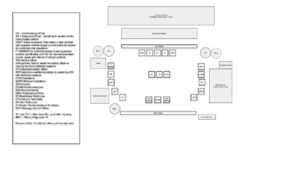TechMemo:Bridge Layout
Home |
Star Fleet Library |
BuPers |
SF Engineering |
SF Intelligence |
SF JAG |
SF Marine Corps |
SF Medical |
SF Records |
SF Sciences
UFP Dept. of Colonial Affairs |
UFP Educational, Scientific and Cultural Org.
Star Fleet Engineering
Bureau of Starship and Starcraft Technology
Star Fleet Engineering
Technical Memorandum
Stardate: 170319 (19 March 2005)
RE: Starship bridge layout
The bridge of a modern starship has a number of common factors. While the precise details of layout vary from one starship design to another, and even between refit versions within the same class, all have certain commonalities. The layout below is the most common modern layout for a starship bridge.
By traditional, the bridge of a Federation starship is places at dorsally on the saucer section, at the "top" of the ship. There has been much debate in Star Fleet Engineering about relocating the bridge to a less tactically vulnerable location. However, Star Fleet's desire to maintain tradition and to focus on the open appearance has continue to hold sway of tactical expediency. Nevertheless, the bridge dome is heavily armored.
The captain's chair is traditionally at the center of the bridge, with the executive officer's and counselor's positions to his right and left, respectively. Like all the bridge positions, the captain's chair has shock frame attachments to hold the captain in place during combat. In addition, several flat and holographic displays and controls louver into and out of the arms or the chair for use during alert situations. While not as large as the main holographic viewscreen or the other bridge displays, these smaller display permit the captain to observe and manipulate data without changing the main display.
Dominating the forward bulkhead is the main holographic display, the "viewscreen." This viewscreen has been a holographic display since the early 2300's. It is generally reserved for navigational data and is often reconfigured to display three dimensional tactical display for proper information flow in combat situations. The main holographic display is also capable of displaying any visual data from the main computer system and communications.
Usually located between the main holographic display and the captain's chair is the maneuvering station. Maneuvering is composed of two positions: helm and astrogration, and is a raised, wide console in the shape of an arc. Astrogation is the bridge station for the ship's navigation and astrogation officer (NAV), whereas the helm is manned by a non-commissioned officer. This person, dubbed the coxswain, actually maneuvers the ship under the direction of the navigator.
The tactical station, with positions for the tactical officer, the assistant tactical officer, and several ratings occupies generally occupies one of two positions on a starship command deck. At one time, the tactical officer stood behind the captain at the center of the bridge. When all bridge positions were again made seated for the safety of personnel, some ships maintained a central raised location for the station. Others moved it to the starboard bulkhead, generally with the tactical officer facing the main display and the tactical team down the side of the bulkhead. Today, the tactical station normally has its own dedicated holographic display, as well as several large flat display screens to provide maximum information flow to the tactical officer. This modern station is usually along the starboard bulkhead of the bridge.
Generally along the port bulkhead opposite the tactical station are the stations for operations, mission operations, sciences, and environmental.
Maintaining their long-time traditional locations, the engineering station and main ship's status board are almost always found along the Aft bulkhead.
Generally, a bridge is served by two turbolifts, located to either side of the Ship's Status board. The entrance to the main briefing room is traditionally next to the starboard turbolift. The entrance to the captain's ready room is forward of the operations station
Forward of tactical is vacuum suit storage. Standard procedure for shipboard personnel is to wear vacuum suits during combat situations. While force fields can seal a hull breach, force fields could fail or have their power cut. In this event, the only thing that would keep the crew alive would be their vacuum suits. Personnel generally have two custom fitted vacuum suits, one in their quarters and another near their battle station. As such, all bridge personnel have a 'suit in vacuum suit storage. All bridge crew members are seated, and every chair has a shock frame attachment designed to latch into a vacuum suit to hold the wearer in their seat.
The entrance to the head is forward of the vacuum suit locker, though it is generally used in non-combat situations and modesty in changing into the skin-tight vacuum suits is ignored in the heat of preparing for combat.
Note: Excepts from correspondence with Scott Freligh were used in the writing of this memorandum.
